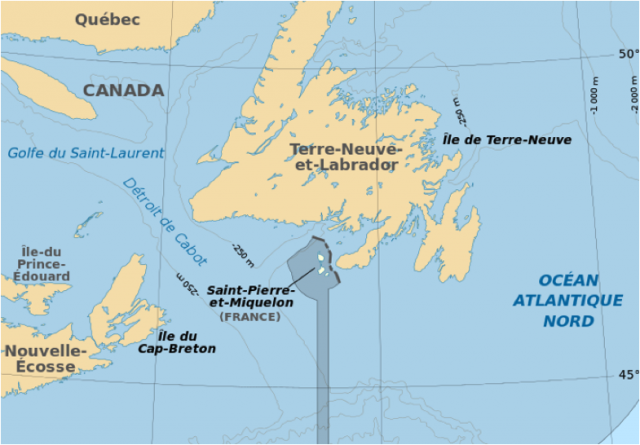Saint-Pierre and Miquelon
AS FRENCH TERRITORIES (93 square mi or 242 square km) and a curious leftover from the chessboard games of colonial diplomacy of the 18th-century great powers, the tiny islands of Saint-Pierre and Miquelon are the only remaining fragments of the once mighty French North American empire. Consisting of two small islands, no more than barren rocks with two small settlements, the territory's small size, however, belies its importance economically as a major source for the French fishing industry.
The islands are a self-governing unit of FRANCE, known as a territorial collectivity since 1986 (a distinction that gives more autonomy). Though 3,000 mi (4,800 km) from France, its residents are full citizens of the republic, with one seat in the Senate and one in the National Assembly. Located at the intersection of the Gulf of Saint Lawrence and the ATLANTIC OCEAN, only 20 mi (32 km) southwest of the Canadian province of Newfoundland, Saint-Pierre and Miquelon are situated strategically within a day's sailing of the Grand Banks, one of the richest commercial fishing areas in the world.

The islands' 74.4 mi (120 km) of coast enable France to claim a much wider exclusive economic zone (EEZ) in the surrounding waters. Long the subject of dispute between France and CANADA, the question of fishing quotas and economic zone resulted in arbitration by a mutually agreed upon international tribunal in 1992, awarding the islands a 4,816-square-mi (12,348-square-km) exclusive economic zone, although this was only a fourth of what France was pushing for. The islands are heavily subsidized by France and are hoping to relieve some of this burden through tests for offshore oil and increased tourism, appealing to visitors' interest in natural wilderness and the islands' legendary cuisine.
The main settlement is on Saint-Pierre, the smaller of the two islands, home to 90 percent of the population. Its terrain is high and rocky, dominated by Mount Galadry. Saint-Pierre has the only harbor deep enough for seagoing vessels. Miquelon is really two islands, Grande Miquelon and Petite Miquelon (also called Langlade), connected by a narrow isthmus, a sandbar that has gradually solidified around numerous shipwrecks between the islands. The second settlement, Miquelon (population 700), is located on a narrow promontory on the far northern end of the island. Six dependent islands surround the main islands, mostly small rocks that are home to seabirds and seals. Miquelon's southern lagoon, Grand Barachois, is also a primary breeding spot for numerous seabirds.
Despite its inhospitable climate—cold and wet, persistent year-round—Breton and Basque sailors attracted to the wealth of the Grand Banks settled on the islands in small numbers from the early 17th century. Others came when French colonists were expelled from Newfoundland in 1713 and Acadia in 1763. As a result of the Treaty of Paris, 1763, France ceded the entirety of its North American possessions in Canada and LOUISIANA to Great Britain, reserving only Saint-Pierre and Miquelon as a consolation prize. Much of the coastline is strewn with wreckage of ships sunk by northeast gales and fogs in this graveyard of the Atlantic.